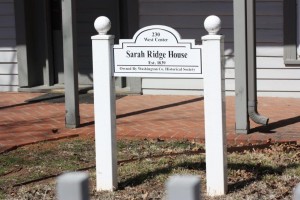As we’ve previously written, the years prior to Arkansas’ statehood were simultaneously exciting and terrifying. The story of Sarah Northrup Ridge and her family demonstrates this dichotomous fact perfectly.
Sarah Northrup’s father was a steward of the Foreign Mission School in Connecticut — one of the school’s founders was Dr Lyman Beecher, father of Harriet Beecher Stowe and patriarch of one of the most influential families of 19th century America. The school was founded as an effort to evangelize and educate people of color and to then train them to go and teach in their native communities. Chinese, Bengalis and Hindus were among the students — by 1820, half of the student population was made up of Native Americans of 6 different tribes.
Among those native Americans was Major John Ridge, a powerful Cherokee tribesman who became smitten with young Sarah. The two defied social norms of the day and married in 1824, centuries before such unions were remotely accepted, much less commonplace. Sarah and her “half-breed” children endured racial prejudice for the rest of their lives as a result of the marriage.
As it is wont to do, gossip among the local citizenry flew with abandon — some accused Dr Beecher of trying to marry off white women to Native Americans to more fully Christianize them. Others maintained that Sarah was only 16 when she was married (she was actually 20); even more creative members of the public asserted that Major Ridge abused his young wife.
The couple decided to relocate to the Cherokee nation in Georgia — no doubt hoping for a more accepting environment to raise their children. They took with them Sophia Sawyer, a young teacher from New Hampshire who the Ridges hired to educate their children.
Unfortunately, a welcome reception was not in the cards — the Cherokee were even less enamored with the marital union in general, and with Marjor Ridge specifically.
Ridge’s father, John Ridge and his cousin Elias Boudinot signed a treaty with the United States government promising the relocation of the Cherokee to Indian territory in Oklahoma. Ridge mistakenly believed that the majority of the Cherokee people would readily agree to the relocation. When they resisted the move, the United States government forced the relocation, resulting in the Trail of Tears, which claimed over 4,000 lives.
The Cherokee fully held the elder Ridge, Major Ridge, and Boudinot alls responsible not only for uprooting their lives, but for the deaths of their fellow tribesman. On June 22, 1839, a mere 24 hours after summer solstice, a group of Cherokee exacted their revenge; they grabbed Ridge from his bed early in the morning and drug him out to his front lawn where they brutally stabbed him 29 times in front of his wife and children.
Sarah’s nightmare didn’t end there — the Cherokee relentlessly slaughtered her cattle and pigs and released her horses, which trampled all of her crops.
At this point, Sarah and her children relocated to Fayetteville, AR where her pristine home stands to this day. She brought along Sophia Sawyer, who immediately began her crusade to enhance education in the area (more on Ms Sawyers’ contributions in a future article.
As for Sarah and her children, their physical safety was ensured in Arkansas, however, their struggle against racial prejudice continued, as it often does among the disenfranchised. The Cherokee nation attempted to claim the Ridge children’s inheritance due to the fact they were only half Cherokee. However, their inheritance was restored to them in 1847.


